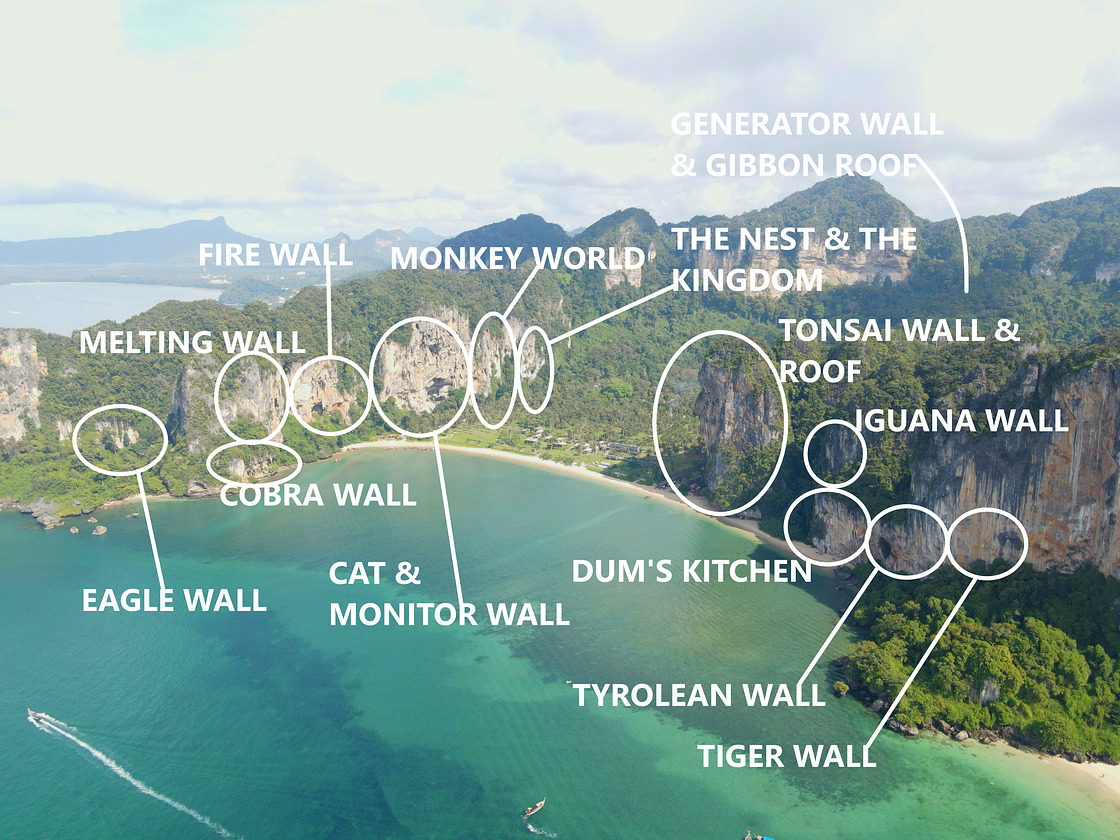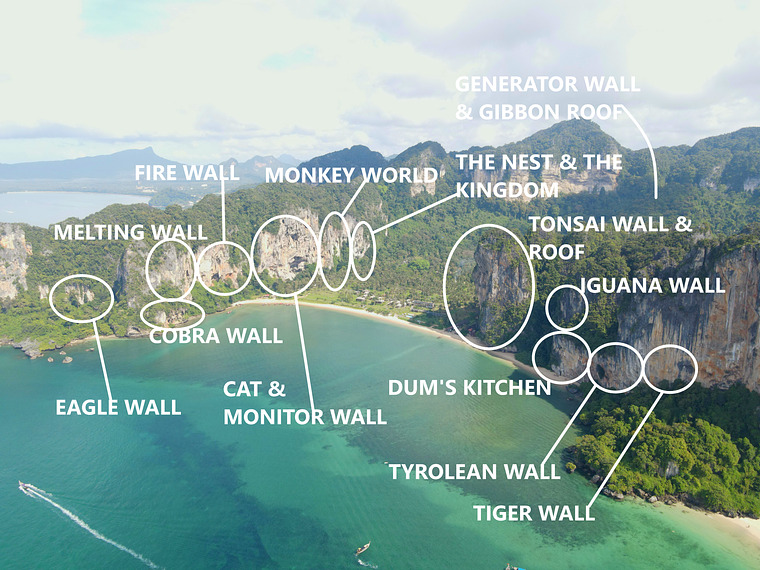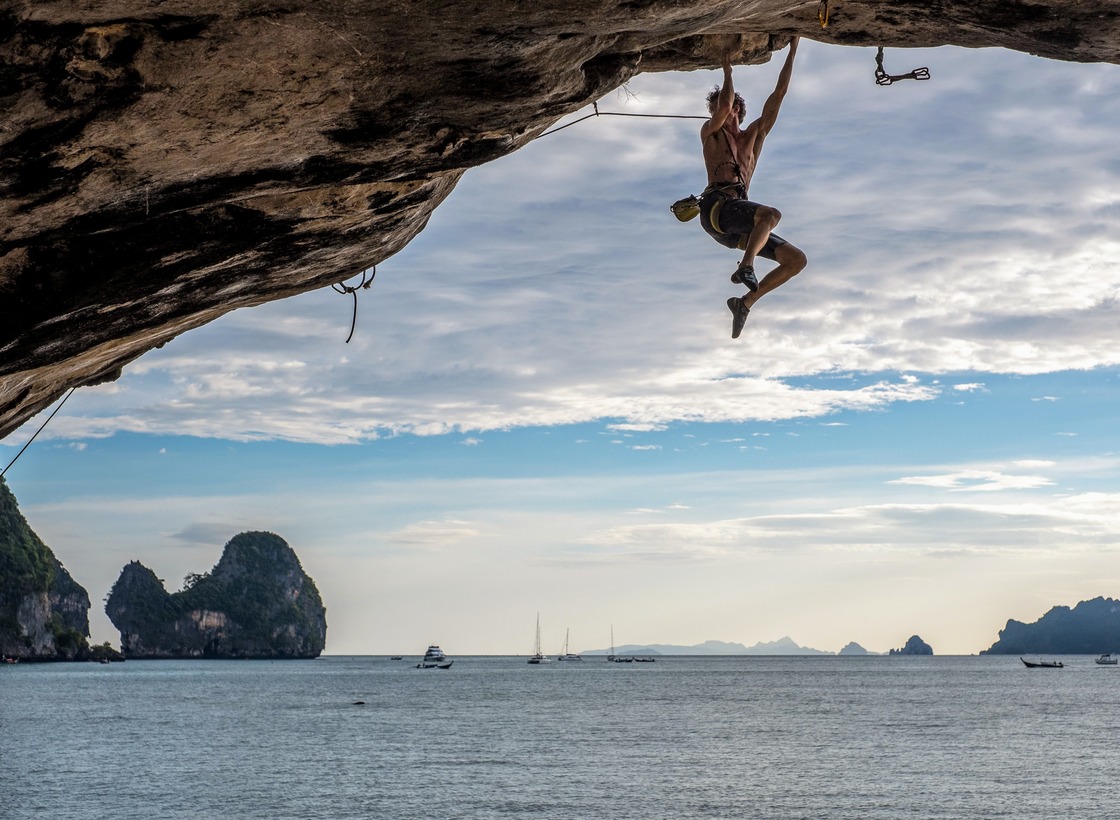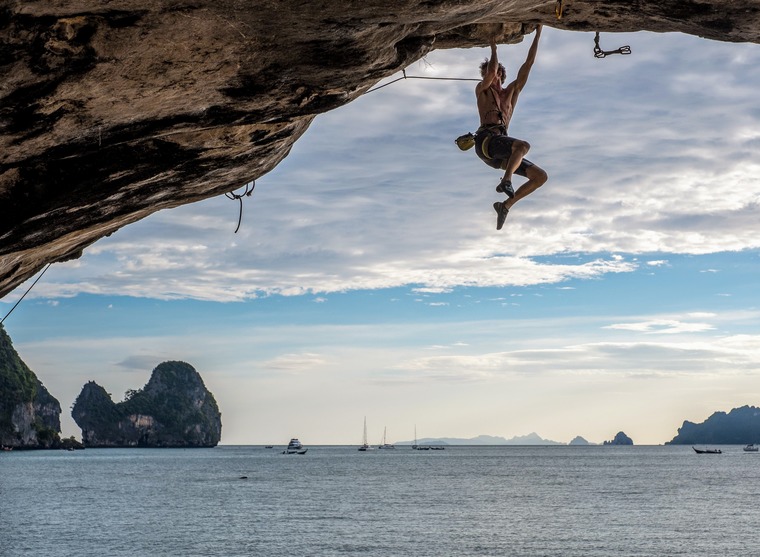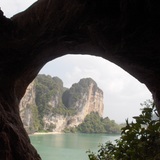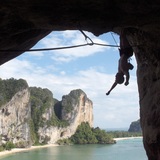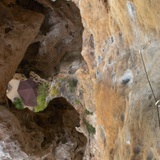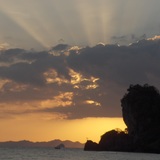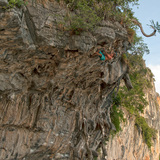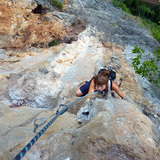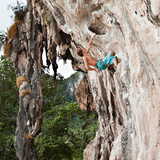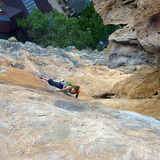⚠️LOW PHONE SIGNAL, DOWNLOAD THE TOPO BEFORE⚠️
🌧️CLIMBABLE IN THE RAIN: "Tonsai Roof", "Dum's Kitchen", "Temple Boulder Cave"
🕶️SHADES DURING THE DAY:
ALWAYS: "Gibbon Roof", "Resort cave", "Temple Boulder Cave"
AFTERNOON: "Eagle Wall", "Cobra Wall", "Melting Wall", "Fire Wall", "Cat Wall", "Monitor Wall", "Lost Wall", "Monkey World", "The Nest", "Marley Wall", "Generator Wall".
MORNING:"Tonsai wall & Roof", "Dum's Kitchen", "Tyrolean Wall", "Tiger Wall", "Iguana Park".
🧱ROCK TYPE:
The rock here is Limestone, with amazing Tufas, Pockets and Jugs, there are very amazing rock formations.
📆 BEST PERIOD:
From November to March, when is cooler and weather is more stable.
👪 FAMILY FRIENDLY:
YES only in: "Tonsai Roof", "Dum's Kitchen", "Tyrolean Wall", "Gibbon Roof", "Tiger Wall", "Temple Boulder Cave"
NO everywhere else.
📱PHONE SIGNAL:
YES with a local simcard, but you can't rely on it.
WI-FI is present in the bars anyway.
⭐GOOD TO KNOW:
In Monitor Wall, on the very rigth part some lines are not drawn due to the fire that caused some rock to not be safe anymore.
🇬🇧
⛰️
Tonsai, the quintessential tropical destination, enchants the soul of the wandering climber, transporting anyone who arrives to an atmosphere of unique gypsy-style tranquility. Climbing takes on an entirely new meaning on this peninsula, accessible only by sea, enveloping the visitor in a sensation of natural fortress.
In this corner of paradise, climbers immerse themselves in a world of diverse challenges: gripping overhangs, technical slabs, multipitch routes— in Tonsai, every climbing desire finds an answer. Cliffs extend in all directions, offering perfect shade both in the morning and afternoon, allowing climbers to challenge themselves with the magnificent tropical scenery as a backdrop.
Accommodation options range from cozy bungalows to hotels, both in Tonsai and nearby Railay Beach, creating a complete travel experience. While climbing, the climber is accompanied by the singing of monkeys, the calls of brightly colored tropical birds, and the presence of many other animals, contributing to the welcoming atmosphere in this climbing paradise.
Tonsai is more than a climbing destination; it's a blend of vertical challenges, breathtaking landscapes, and a warm community, creating a seamless and engaging experience for those seeking adventure in an untouched tropical environment.
The most famous cliff in Tonsai is undoubtedly "Tonsai Roof," seen in climbing magazines or videos. It is the icon of climbing in Tonsai, a roof with concretions of all kinds, right on the beach, irresistible. The nearby "Dum's Kitchen" encompasses a high number of routes, also holding the record for Tonsai's most challenging route, "Greed." Here, with your feet in the sand, you have the opportunity to climb, whether you are a novice or an expert.
Following that is the Tyrolean Wall, a continuation of the previous one, with short and fun routes. A little higher up is "Tiger Wall," requiring verticality and steel-like fingers for this small gem of technique. On the other side of the bay, we have Eagle Wall and Cobra Wall, suitable for everyone and a lot of fun, with stalactites creating an incredible scenery. To their right is "Melting Wall," a beautiful wall with 5-star lines on very compact rock. Continuing, there is also "Fire Wall," where a large cave hides truly spectacular lines to observe the bay from above.
Next, we come to "Cat Wall & Monitor Wall,", where the truly massive wall has been divided into two sectors to facilitate guide understanding. Crazy multipitch climbs are offered by this breathtaking wall. From the base, lift your eyes, and you will realize how imposing it is. Immediately adjacent is "Monkey World," a cliff that, with a handful of multipitch routes, provides strong emotions and beautiful views from above. At the base of the latter, there is a large cave with many bouldering passages, also reviewed here in the guide.
"The Nest" and "Kingdom Wall" are high-quality climbs on rock ranging from gray to red. The climbing is sustained but provides strong emotions. Let's not forget about "Gibbon Roof" for enthusiasts of overhangs; this is paradise, a 15-meter roof with large holes and stalactites, an incredible place for steel biceps. The mosquitoes are numerous, many, bring mosquito repellent!
"Generator Wall," currently not re-bolted, has stunning rock, but unfortunately, at the moment, it is strongly discouraged to climb on it.
🇩🇪
⛰️
Tonsai, das Wesen des tropischen Reiseziels schlechthin, verzaubert die Seele des wandernden Kletterers und transportiert jeden, der ankommt, in eine Atmosphäre einzigartiger gypsyartiger Gelassenheit. Das Klettern erhält auf dieser Halbinsel, die nur auf dem Seeweg erreichbar ist, eine völlig neue Bedeutung und hüllt den Besucher in ein Gefühl natürlicher Festung.
In diesem Paradieswinkel tauchen Kletterer in eine Welt vielfältiger Herausforderungen ein: ergreifende Überhänge, technische Platten, Mehrseillängenrouten - in Tonsai findet jede kletternde Sehnsucht eine Antwort. Die Felsen erstrecken sich in alle Richtungen und bieten sowohl am Morgen als auch am Nachmittag perfekten Schatten, sodass Kletterer sich mit der prächtigen tropischen Landschaft im Hintergrund herausfordern können.
Die Unterkunftsmöglichkeiten reichen von gemütlichen Bungalows bis zu Hotels, sowohl in Tonsai als auch im nahegelegenen Railay Beach, und schaffen so ein umfassendes Reiseerlebnis. Beim Klettern wird der Kletterer vom Gesang der Affen, den Rufen von bunten tropischen Vögeln und der Anwesenheit vieler anderer Tiere begleitet, was zur einladenden Atmosphäre in diesem Kletterparadies beiträgt.
Tonsai ist mehr als nur ein Kletterziel; es ist eine Mischung aus vertikalen Herausforderungen, atemberaubenden Landschaften und einer herzlichen Gemeinschaft, die ein nahtloses und fesselndes Erlebnis für diejenigen schafft, die Abenteuer in einer unberührten tropischen Umgebung suchen.
Die berühmteste Felswand in Tonsai ist zweifellos "Tonsai Roof", wie in Klettermagazinen oder Videos zu sehen. Sie ist das Symbol des Kletterns in Tonsai, ein Dach mit Ablagerungen aller Art, direkt am Strand, unwiderstehlich. Die nahe gelegene "Dum's Kitchen" umfasst eine hohe Anzahl von Routen und hält auch den Rekord für die anspruchsvollste Route von Tonsai, "Greed". Hier haben Sie mit den Füßen im Sand die Möglichkeit zu klettern, egal ob Sie Anfänger oder Experte sind.
Darauf folgt die Tyrolean Wall, eine Fortsetzung der vorherigen, mit kurzen und unterhaltsamen Routen. Ein wenig weiter oben befindet sich die "Tiger Wall", die Vertikalität und stahlähnliche Finger für dieses kleine Juwel der Technik erfordert. Auf der anderen Seite der Bucht haben wir Eagle Wall und Cobra Wall, für alle geeignet und sehr unterhaltsam, mit Stalaktiten, die eine unglaubliche Kulisse schaffen. Rechts von ihnen befindet sich die "Melting Wall", eine wunderschöne Wand mit 5-Sterne-Linien auf sehr kompaktem Fels. Weiter geht es mit der "Fire Wall", wo eine große Höhle wirklich spektakuläre Linien zum Beobachten der Bucht von oben verbirgt.
Als nächstes kommen wir zu "Cat Wall & Monitor Wall", wo die wirklich massive Wand in zwei Sektoren unterteilt wurde, um das Verständnis des Führers zu erleichtern. Von der Basis aus heben Sie den Blick, und Sie werden feststellen, wie beeindruckend es ist. Gleich daneben befindet sich "Monkey World", eine Felswand, die mit einer Handvoll Mehrseillängenrouten starke Emotionen und wunderschöne Ausblicke von oben bietet. An der Basis letzterer befindet sich eine große Höhle mit vielen Boulderpassagen, die ebenfalls hier im Führer überprüft wurden.
"The Nest" und "Kingdom Wall" sind hochwertige Kletterrouten auf Felsen, die von Grau bis Rot reichen. Das Klettern ist anstrengend, aber es sorgt für starke Emotionen. Nicht zu vergessen ist "Gibbon Roof" für Liebhaber von Überhängen; dies ist das Paradies, ein 15 Meter hohes Dach mit großen Löchern und Stalaktiten, ein unglaublicher Ort für stählerne Bizepse. Die Mücken sind zahlreich, bringt Mückenschutzmittel mit!
"Generator Wall", derzeit nicht neu verschraubt, hat beeindruckenden Fels, aber leider wird im Moment dringend davon abgeraten, dort zu klettern.
🇫🇷
⛰️
Tonsai, la destination tropicale par excellence, enchante l'âme du grimpeur errant, transportant quiconque y arrive dans une atmosphère de tranquillité unique au style gypsy. L'escalade prend un tout nouveau sens sur cette péninsule, accessible uniquement par la mer, enveloppant le visiteur dans une sensation de forteresse naturelle.
Dans ce coin de paradis, les grimpeurs se plongent dans un monde de défis diversifiés : des surplombs saisissants, des dalles techniques, des voies multipitch. À Tonsai, chaque désir d'escalade trouve une réponse. Les falaises s'étendent dans toutes les directions, offrant une ombre parfaite le matin et l'après-midi, permettant aux grimpeurs de se mettre au défi avec le magnifique paysage tropical en arrière-plan.
Les options d'hébergement vont des bungalows confortables aux hôtels, tant à Tonsai qu'à la proche Railay Beach, créant une expérience de voyage complète. En escaladant, le grimpeur est accompagné par le chant des singes, les cris d'oiseaux tropicaux aux couleurs vives et la présence de nombreux autres animaux, contribuant à l'atmosphère accueillante de ce paradis de l'escalade.
Tonsai est plus qu'une destination d'escalade ; c'est un mélange de défis verticaux, de paysages à couper le souffle et d'une communauté chaleureuse, créant une expérience fluide et captivante pour ceux qui recherchent l'aventure dans un environnement tropical préservé.
La falaise la plus célèbre à Tonsai est sans aucun doute "Tonsai Roof", vue dans des magazines d'escalade ou des vidéos. C'est l'icône de l'escalade à Tonsai, un toit avec des concrétions de toutes sortes, directement sur la plage, irrésistible. La "Dum's Kitchen" voisine englobe un grand nombre de voies, détenant également le record de la voie la plus difficile de Tonsai, "Greed". Ici, les pieds dans le sable, vous avez l'opportunité de grimper, que vous soyez novice ou expert.
En suivant, on trouve le Tyrolean Wall, une continuation de la précédente, avec des voies courtes et amusantes. Un peu plus haut se trouve "Tiger Wall", exigeant verticalité et doigts d'acier pour cette petite perle de technique. De l'autre côté de la baie, nous avons Eagle Wall et Cobra Wall, adaptées à tous et très amusantes, avec des stalactites créant un décor incroyable. À leur droite se trouve "Melting Wall", un magnifique mur avec des lignes 5 étoiles sur une roche très compacte. En continuant, il y a aussi "Fire Wall", où une grande grotte cache des lignes vraiment spectaculaires pour observer la baie d'en haut.
Ensuite, nous arrivons à "Cat Wall & Monitor Wall", où le mur vraiment massif a été divisé en deux secteurs pour faciliter la compréhension du guide. Des escalades multipitch folles sont offertes par ce mur à couper le souffle. De la base, levez les yeux, et vous réaliserez à quel point il est imposant. Immédiatement à côté se trouve "Monkey World", une falaise qui, avec une poignée de voies multipitch, offre des émotions fortes et de magnifiques vues d'en haut. À la base de cette dernière, il y a une grande grotte avec de nombreux passages de blocs, également examinés ici dans le guide.
"The Nest" et "Kingdom Wall" sont des escalades de haute qualité sur une roche allant du gris au rouge. L'escalade est soutenue mais procure des émotions fortes. N'oublions pas "Gibbon Roof" pour les amateurs de dévers ; c'est le paradis, un toit de 15 mètres avec de gros trous et des stalactites, un endroit incroyable pour des biceps en acier. Les moustiques sont nombreux, beaucoup, apportez un répulsif anti-moustiques !
"Generator Wall", actuellement non re-boulonné, a une roche magnifique, mais malheureusement, en ce moment, il est fortement déconseillé d'y grimper.
